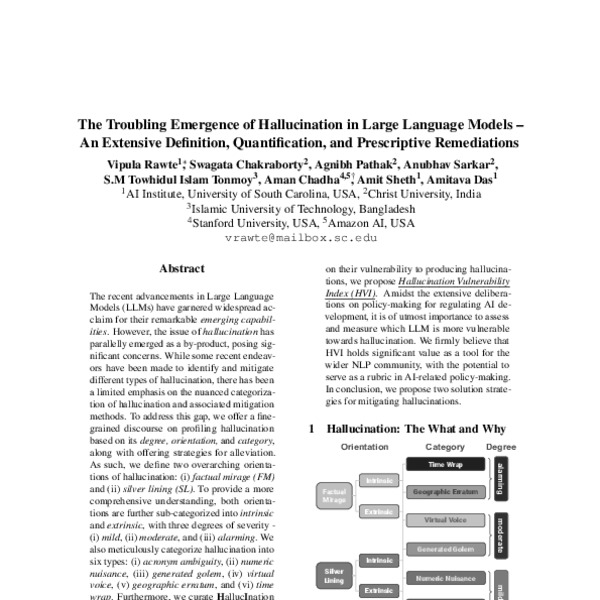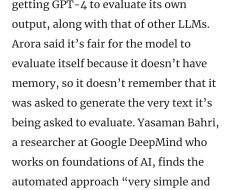
@inproceedings{rawte-etal-2023-troubling,
title = "The Troubling Emergence of Hallucination in Large Language Models - An Extensive Definition, Quantification, and Prescriptive Remediations",
author = "Rawte, Vipula and
Chakraborty, Swagata and
Pathak, Agnibh and
Sarkar, Anubhav and
Tonmoy, S.M Towhidul Islam and
Chadha, Aman and
Sheth, Amit and
Das, Amitava",
editor = "Bouamor, Houda and
Pino, Juan and
Bali, Kalika",
booktitle = "Proceedings of the 2023 Conference on Empirical Methods in Natural Language Processing",
month = dec,
year = "2023",
address = "Singapore",
publisher = "Association for Computational Linguistics",
url = "https://aclanthology.org/2023.emnlp-main.155",
doi = "10.18653/v1/2023.emnlp-main.155",
pages = "2541--2573",
abstract = "The recent advancements in Large Language Models (LLMs) have garnered widespread acclaim for their remarkable emerging capabilities. However, the issue of hallucination has parallelly emerged as a by-product, posing significant concerns. While some recent endeavors have been made to identify and mitigate different types of hallucination, there has been a limited emphasis on the nuanced categorization of hallucination and associated mitigation methods. To address this gap, we offer a fine-grained discourse on profiling hallucination based on its degree, orientation, and category, along with offering strategies for alleviation. As such, we define two overarching orientations of hallucination: (i) factual mirage (FM) and (ii) silver lining (SL). To provide a more comprehensive understanding, both orientations are further sub-categorized into intrinsic and extrinsic, with three degrees of severity - (i) mild, (ii) moderate, and (iii) alarming. We also meticulously categorize hallucination into six types: (i) acronym ambiguity, (ii) numeric nuisance, (iii) generated golem, (iv) virtual voice, (v) geographic erratum, and (vi) time wrap. Furthermore, we curate HallucInation eLiciTation (HILT), a publicly available dataset comprising of 75,000 samples generated using 15 contemporary LLMs along with human annotations for the aforementioned categories. Finally, to establish a method for quantifying and to offer a comparative spectrum that allows us to evaluate and rank LLMs based on their vulnerability to producing hallucinations, we propose Hallucination Vulnerability Index (HVI). Amidst the extensive deliberations on policy-making for regulating AI development, it is of utmost importance to assess and measure which LLM is more vulnerable towards hallucination. We firmly believe that HVI holds significant value as a tool for the wider NLP community, with the potential to serve as a rubric in AI-related policy-making. In conclusion, we propose two solution strategies for mitigating hallucinations.",
}
<?xml version="1.0" encoding="UTF-8"?>
<modsCollection xmlns="http://www.loc.gov/mods/v3">
<mods ID="rawte-etal-2023-troubling">
<titleInfo>
<title>The Troubling Emergence of Hallucination in Large Language Models - An Extensive Definition, Quantification, and Prescriptive Remediations</title>
</titleInfo>
<name type="personal">
<namePart type="given">Vipula</namePart>
<namePart type="family">Rawte</namePart>
<role>
<roleTerm authority="marcrelator" type="text">author</roleTerm>
</role>
</name>
<name type="personal">
<namePart type="given">Swagata</namePart>
<namePart type="family">Chakraborty</namePart>
<role>
<roleTerm authority="marcrelator" type="text">author</roleTerm>
</role>
</name>
<name type="personal">
<namePart type="given">Agnibh</namePart>
<namePart type="family">Pathak</namePart>
<role>
<roleTerm authority="marcrelator" type="text">author</roleTerm>
</role>
</name>
<name type="personal">
<namePart type="given">Anubhav</namePart>
<namePart type="family">Sarkar</namePart>
<role>
<roleTerm authority="marcrelator" type="text">author</roleTerm>
</role>
</name>
<name type="personal">
<namePart type="given">S.M</namePart>
<namePart type="given">Towhidul</namePart>
<namePart type="given">Islam</namePart>
<namePart type="family">Tonmoy</namePart>
<role>
<roleTerm authority="marcrelator" type="text">author</roleTerm>
</role>
</name>
<name type="personal">
<namePart type="given">Aman</namePart>
<namePart type="family">Chadha</namePart>
<role>
<roleTerm authority="marcrelator" type="text">author</roleTerm>
</role>
</name>
<name type="personal">
<namePart type="given">Amit</namePart>
<namePart type="family">Sheth</namePart>
<role>
<roleTerm authority="marcrelator" type="text">author</roleTerm>
</role>
</name>
<name type="personal">
<namePart type="given">Amitava</namePart>
<namePart type="family">Das</namePart>
<role>
<roleTerm authority="marcrelator" type="text">author</roleTerm>
</role>
</name>
<originInfo>
<dateIssued>2023-12</dateIssued>
</originInfo>
<typeOfResource>text</typeOfResource>
<relatedItem type="host">
<titleInfo>
<title>Proceedings of the 2023 Conference on Empirical Methods in Natural Language Processing</title>
</titleInfo>
<name type="personal">
<namePart type="given">Houda</namePart>
<namePart type="family">Bouamor</namePart>
<role>
<roleTerm authority="marcrelator" type="text">editor</roleTerm>
</role>
</name>
<name type="personal">
<namePart type="given">Juan</namePart>
<namePart type="family">Pino</namePart>
<role>
<roleTerm authority="marcrelator" type="text">editor</roleTerm>
</role>
</name>
<name type="personal">
<namePart type="given">Kalika</namePart>
<namePart type="family">Bali</namePart>
<role>
<roleTerm authority="marcrelator" type="text">editor</roleTerm>
</role>
</name>
<originInfo>
<publisher>Association for Computational Linguistics</publisher>
<place>
<placeTerm type="text">Singapore</placeTerm>
</place>
</originInfo>
<genre authority="marcgt">conference publication</genre>
</relatedItem>
<abstract>The recent advancements in Large Language Models (LLMs) have garnered widespread acclaim for their remarkable emerging capabilities. However, the issue of hallucination has parallelly emerged as a by-product, posing significant concerns. While some recent endeavors have been made to identify and mitigate different types of hallucination, there has been a limited emphasis on the nuanced categorization of hallucination and associated mitigation methods. To address this gap, we offer a fine-grained discourse on profiling hallucination based on its degree, orientation, and category, along with offering strategies for alleviation. As such, we define two overarching orientations of hallucination: (i) factual mirage (FM) and (ii) silver lining (SL). To provide a more comprehensive understanding, both orientations are further sub-categorized into intrinsic and extrinsic, with three degrees of severity - (i) mild, (ii) moderate, and (iii) alarming. We also meticulously categorize hallucination into six types: (i) acronym ambiguity, (ii) numeric nuisance, (iii) generated golem, (iv) virtual voice, (v) geographic erratum, and (vi) time wrap. Furthermore, we curate HallucInation eLiciTation (HILT), a publicly available dataset comprising of 75,000 samples generated using 15 contemporary LLMs along with human annotations for the aforementioned categories. Finally, to establish a method for quantifying and to offer a comparative spectrum that allows us to evaluate and rank LLMs based on their vulnerability to producing hallucinations, we propose Hallucination Vulnerability Index (HVI). Amidst the extensive deliberations on policy-making for regulating AI development, it is of utmost importance to assess and measure which LLM is more vulnerable towards hallucination. We firmly believe that HVI holds significant value as a tool for the wider NLP community, with the potential to serve as a rubric in AI-related policy-making. In conclusion, we propose two solution strategies for mitigating hallucinations.</abstract>
<identifier type="citekey">rawte-etal-2023-troubling</identifier>
<identifier type="doi">10.18653/v1/2023.emnlp-main.155</identifier>
<location>
<url>https://aclanthology.org/2023.emnlp-main.155</url>
</location>
<part>
<date>2023-12</date>
<extent unit="page">
<start>2541</start>
<end>2573</end>
</extent>
</part>
</mods>
</modsCollection>
%0 Conference Proceedings %T The Troubling Emergence of Hallucination in Large Language Models - An Extensive Definition, Quantification, and Prescriptive Remediations %A Rawte, Vipula %A Chakraborty, Swagata %A Pathak, Agnibh %A Sarkar, Anubhav %A Tonmoy, S.M Towhidul Islam %A Chadha, Aman %A Sheth, Amit %A Das, Amitava %Y Bouamor, Houda %Y Pino, Juan %Y Bali, Kalika %S Proceedings of the 2023 Conference on Empirical Methods in Natural Language Processing %D 2023 %8 December %I Association for Computational Linguistics %C Singapore %F rawte-etal-2023-troubling %X The recent advancements in Large Language Models (LLMs) have garnered widespread acclaim for their remarkable emerging capabilities. However, the issue of hallucination has parallelly emerged as a by-product, posing significant concerns. While some recent endeavors have been made to identify and mitigate different types of hallucination, there has been a limited emphasis on the nuanced categorization of hallucination and associated mitigation methods. To address this gap, we offer a fine-grained discourse on profiling hallucination based on its degree, orientation, and category, along with offering strategies for alleviation. As such, we define two overarching orientations of hallucination: (i) factual mirage (FM) and (ii) silver lining (SL). To provide a more comprehensive understanding, both orientations are further sub-categorized into intrinsic and extrinsic, with three degrees of severity - (i) mild, (ii) moderate, and (iii) alarming. We also meticulously categorize hallucination into six types: (i) acronym ambiguity, (ii) numeric nuisance, (iii) generated golem, (iv) virtual voice, (v) geographic erratum, and (vi) time wrap. Furthermore, we curate HallucInation eLiciTation (HILT), a publicly available dataset comprising of 75,000 samples generated using 15 contemporary LLMs along with human annotations for the aforementioned categories. Finally, to establish a method for quantifying and to offer a comparative spectrum that allows us to evaluate and rank LLMs based on their vulnerability to producing hallucinations, we propose Hallucination Vulnerability Index (HVI). Amidst the extensive deliberations on policy-making for regulating AI development, it is of utmost importance to assess and measure which LLM is more vulnerable towards hallucination. We firmly believe that HVI holds significant value as a tool for the wider NLP community, with the potential to serve as a rubric in AI-related policy-making. In conclusion, we propose two solution strategies for mitigating hallucinations. %R 10.18653/v1/2023.emnlp-main.155 %U https://aclanthology.org/2023.emnlp-main.155 %U https://doi.org/10.18653/v1/2023.emnlp-main.155 %P 2541-2573
Markdown (Informal)
[The Troubling Emergence of Hallucination in Large Language Models – An Extensive Definition, Quantification, and Prescriptive Remediations](https://aclanthology.org/2023.emnlp-main.155) (Rawte et al., EMNLP 2023)
ACL
- Vipula Rawte, Swagata Chakraborty, Agnibh Pathak, Anubhav Sarkar, S.M Towhidul Islam Tonmoy, Aman Chadha, Amit Sheth, and Amitava Das. 2023. The Troubling Emergence of Hallucination in Large Language Models – An Extensive Definition, Quantification, and Prescriptive Remediations. In Proceedings of the 2023 Conference on Empirical Methods in Natural Language Processing, pages 2541–2573, Singapore. Association for Computational Linguistics.




